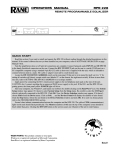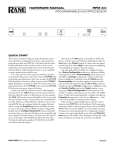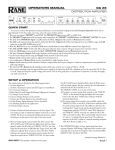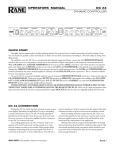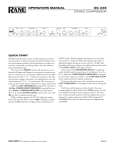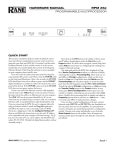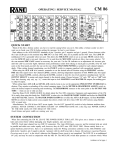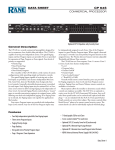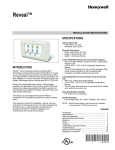Download Rane AD-13- Operating instructions
Transcript
OPERATORS MANUAL AD 22d AUDIO DELAY 1 SENSITIVITY -10 dBV -8 -12 -4 0 -16 +4 SIGNAL -20 dBu 2 SENSITIVITY -10 dBV -8 -12 0 2 A B 1 2 -16 +4 CLIP 1 -4 SIGNAL -20 dBu MILLISECONDS FEET BYPASS CLIP DISPLAY MODE STORE RECALL CHAN MEMORY 1 ms 10 μs COARSE FINE AD 22d AUDIO DELAY METERS HOLD TO SET TEMP °C °F QUICK START Quickly look around to make sure no one catches you reading this. You’re aware this is the manual aren’t you? Wow! Most people only get about this far in a manual, but there are a few important things you should know about the AD 22d. So please keep reading. These few points are summarized in this Cliff Note version of the manual. ADJUSTING SENSITIVITY. First apply a signal with nominal input level and adjust the SENSITIVITY controls so the red CLIP LEDs just light, then back off so the LEDs do not turn on, even with high signal peaks. SETTING DELAY. Now that the input signal is calibrated, press the CHAN button until the CHAN LEDs indicate the channel you want to set. We cover the special case of adjusting both channels simultaneously later (both CHAN LEDs on). Adjust the up/down buttons until the LED display shows the desired Delay. To adjust the Delay of the other channel press the CHAN button until the other channel’s LED is lit, and adjust the Delay as before. STORING DELAY. Press the STORE button (the STORE LED stops flashing). This stores the current Delay values into each channel’s current Memory (A or B). The current Memory for each channel is indicated by the MEMORY LED lit when editing that channel. Both channel's current Delay values are stored with each press of the STORE button. WEAR PARTS: This product contains no wear parts. RECALLING DELAY. To recall a stored Memory, press RECALL. Each press of this button alternately recalls stored Memories (A then B then A…) for the selected channel only. A quick way to recall Memories into both channels simultaneously, is to store both channel’s values into the same Memory. With both channels selected (both CHAN LEDs on), press RECALL to restore both channel’s Memories at the same time. SETTING TEMPERATURE. The AD 22d is factory set for 22°C/71.6°F. To change this, press and hold DISPLAY MODE and press one of the up/down buttons. Use the 1ms/COARSE buttons for degrees Celsius or the 10µs/FINE buttons for degrees Fahrenheit. The LED display shows the temperature setting. Further pressing of the up/down buttons adjusts the temperature setting. This temperature is used, with constant 30% humidity, to calculate the speed of sound for converting delay times into distance. Never connect anything except an approved Rane power supply to the red thing that looks like a telephone jack on the rear of the unit. This is an AC input and requires special attention if you do not have a power supply exactly like the one originally packed with your unit. See the full explanation of the power supply requirements elsewhere in this manual. Note: Changing the Delay setting is nearly seamless, though a single audio click may be expected if an audio signal is present. Manual- FRONT PANEL DESCRIPTION 1 1 4 5 7 9 2 3 SENSITIVITY -10 dBV -8 -12 2 -4 0 -16 +4 SIGNAL SENSITIVITY -10 dBV -8 -12 0 -20 dBu 2 A B 1 2 BYPASS CLIP 2 MILLISECONDS FEET -20 dBu SIGNAL 1 DISPLAY MODE -16 +4 CLIP 1 -4 11 3 STORE RECALL CHAN MEMORY 6 8 10 1 ms 10 μs COARSE FINE AD 22d AUDIO DELAY METERS HOLD TO SET TEMP 14 °C 12 °F 13 1 SIGNAL LEDs: illuminate green 34 dB before clipping. 2 SENSITIVITY controls: vary incoming signal levels to the A to D converter. The output signal is also adjusted so the AD 22d always passes signal with unity gain. (See operating instructions.) 3 CLIP LEDs: illuminate red 4 dB before clipping at the A to D converter input. 4 BYPASS buttons & LEDs: These momentary push buttons toggle each channel’s hard-wired Bypass. If an LED is on, the given channel is Bypassed and functions like a wire. If it is off the given channel is active. 5 STORE LED: flashes green when the current configuration of the AD 22d is different from the stored configuration. The STORE LED is off when the current configuration matches the stored configuration. 6 STORE button: Stores the current Delay configuration into both channel’s current Memory (A or B). The current Memory for each channel is indicated by the MEMORY LED which is lit when editing that channel. 7 MEMORY LEDs: indicate the most recently recalled Memory, A or B, for each channel by illuminating yellow. They also indicate the Memory that is written to when the STORE button is pressed. The MEMORY LED flashes when the current Delay value for the selected channel is different than the stored value for the selected channel. 8 RECALL button: Pressing this pushbutton alternately Recalls stored Memories A and B, for the channels(s) indicated by the green CHAN LEDs. 9 CHANNEL LEDs: indicate the channel number whose value is currently being displayed in the LED display and whose current Delay value is editable by illuminating green. If both CHAN LEDs are on, both channel’s current Delay values are editable. In this edit BOTH mode, the LED display shows the smaller of the two current Delay values and the memory LEDs turn off if the two channel’s current Memories are not the same. 0 CHANNEL button: Pressing this button advances the channel LEDs from CHAN 1 to CHAN 2 to BOTH. The current Delay value of the selected channel is displayed in the LED display. q DISPLAY MODE button & LEDs: This button changes the units of displayed Delay values from Milliseconds to Feet to Meters. The LEDs indicate the current Display Mode: MILLISECONDS, FEET or METERS. w 5-digit LED display: indicates the current Delay value for the selected channel. When both channels are selected, the smaller of the two channel’s current Delay values is displayed. This display also shows the current temperature setting when holding down the DISPLAY MODE button and pressing one of the up/down buttons. On power-up the current software revision is displayed. e UP/DOWN buttons: Pressing these buttons increases/decreases the amount of Delay in the selected Channel(s). The two buttons just to the right of the LED display change Delay time in 1 millisecond steps. The far right buttons provide 10 microsecond steps. For distance displays (feet and meters), these buttons are FINE and COARSE adjustments, since Delay increments are always in 1 msec and 10 µsec steps, regardless of the DISPLAY MODE. r TEMPERATURE setting: Holding down DISPLAY MODE while pressing the up/down buttons displays the current temperature setting in degrees Celsius for the 1 msec/COARSE buttons and degrees Fahrenheit for the 10 µsec/FINE buttons. Further up/down presses change the temperature setting. No matter which unit (°C or °F), adjustments are always in 1°C steps (or 1.8°F). Manual- REAR PANEL DESCRIPTION REMOTE RECALL POWER 650mA CLASS 2 EQUIPMENT 1 2 OPEN MEM A CH 2 OUT CH 2 IN CH 1 OUT CH 1 IN BALANCED WIRING: PIN 2 POSITIVE PIN 3 NEGATIVE PIN 1 CHASSIS GND CLOSED MEM B CH1 CH2 3 GND CH 2 OUT 4 CH 2 IN CH 1 OUT REMOTE RECALL PORT: 5 VOLT SOURCES 0.5 mA CMOS SCHMITT TRIGGER INPUTS THIS DEVICE COMPLIES WITH PART 15 OF THE FCC RULES. OPERATION IS SUBJECT TO THE FOLLOWING TWO CONDITIONS: (1) THIS DEVICE MAY NOT CAUSE HARMFUL INTERFERENCE, AND (2) THIS DEVICE MUST ACCEPT ANY INTERFERENCE THAT MAY CAUSE UNDESIRED OPERATION. AD 22d MADE IN U.S.A. RANE CORP. ACN 001 345 482 CH 1 IN 5 1 Chassis ground point: A #6-32 screw and toothed washer is provided for chassis ground. Since the AD 22d does not get chassis ground through the AC cord, this point is provided in case your system does not have another earth ground such as the rack rails. See the CHASSIS GROUNDING note below. 2 POWER input connector: No this is not where Commissioner Gordon plugs in his Bat-phone, in fact it is not a telephone jack at all. The AD 22d uses an 18 volt AC center-tapped transformer only. Use only a model RS 1 or other remote AC power supply approved by Rane. The AD 22d is supplied with a remote power supply suitable for connection to this jack. Consult the factory for replacement or substitution. 3 REMOTE RECALL terminals: Wiring external configuration switches to these terminals allows remote recall of the two nonvolatile memories for each Channel. When the switch closes, Memory B for the given Channel is recalled. When the switch opens, Memory A is recalled. These terminals use CMOS (+5 volt) logic levels and sink only 0.5 mA (max.) each. 4 Recessed lockout switch: Enables the Front Panel Lockout mode. In this mode all front panel controls, with the exception of the CHAN and DISPLAY MODE buttons, are disabled. The Channel button remains active so the user may view the current Delay values without risk of changing them, and the display mode button allows display of Delay values in milliseconds, feet or meters. Press RECALL while in LOCKOUT to temporarily display, but not Recall, the value of the other stored Memory for the indicated channel. (See OPERATING INSTRUCTIONS for optional Bypass lockout mode, and MEMORY BUTTONS on previous page.) 5 INPUT/OUTPUT connectors: Nothing new here, the AD 22d uses balanced XLRs, with pin 2 “hot” per AES standards. FCC NOTICE This equipment has been tested and found to comply with the limits for a Class B digital device, pursuant to Part 15 of the FCC Rules. These limits are designed to provide reasonable protection against harmful interference when the equipment is operated in a residential installation. This equipment generates, uses, and can radiate radio frequency energy and, if not installed and used in accordance with the instructions, may cause harmful interference to radio communications. However, there is no guarantee that interference will not occur in a particular installation. If this equipment does cause harmful interference to radio or television reception, which can be determined by turning the equipment off and on, the user is encouraged to try to correct the interference by one or more of the following: 1. Re-orient or relocate the receiving antenna. 2. Increase the separation between the equipment and the receiver. 3. Connect the equipment into an outlet on a circuit different from that to which the receiver is connected. 4. Consult the dealer or an experienced radio/TV technician. CANADIAN EMC NOTICE This Class B digital apparatus meets all requirements of the Canadian Interference-Causing Equipment Regulations. Cet Appariel numerique de la classe B respecte toutes les exigences du Reglement sur le material broilleur du Canada. CHASSIS GROUNDING If after hooking up your system it exhibits excessive hum or buzzing, there is an incompatibility in the grounding configuration between units. Here are some things to try: 1. Try combinations of lifting grounds on units supplied with ground lift switches (or links). 2. Verify all chassis are tied to a good earth ground. 3. Some units with outboard power supplies do not ground the chassis through the line cord. Make sure these units are solidly grounded by tying the Chassis Ground Point to known earth ground. Use a star washer to guarantee proper contact. Manual- AD 22d CONNECTION When connecting the AD 22d to other components in your system for the first time, leave the power supply for last. This gives you a chance to make mistakes and correct them before any damage is done to your fragile speakers, headphones, ears, or brains. The AD 22d passes audio while it is unpowered by virtue of its fail safe bypass relays (when the AD 22d functions as a wire). Turn the system volume down before plugging in the AD 22d’s power. INPUTS AND OUTPUTS The AD 22d’s Inputs and Outputs are electronically balanced, so use only balanced wiring. The AD 22d’s shields (pin 1) connect to chassis ground. Pin 2 is “hot” per AES standards. REMOTE RECALL TERMINALS Each channel of the AD 22d has two nonvolatile Memories, “A” and “B”. Connecting a switch between the GND and CH1 or CH2 terminals permits recalling the Memories remotely. Only a change in the switch position is sensed—when the switch closes, Memory B for the given channel is recalled. When the switch opens, Memory A is recalled. Connecting the two channel terminals (CH1 & CH2) together on one side of the same switch, permits stereo recall of Memories A and B. OPERATING INSTRUCTIONS Once you have properly connected the AD 22d to the system, turn on the power. When the AD 22d is first powered it displays the words “RANE” and “Ad 22”. Then, the unit’s software revision level is briefly displayed. The first time you power the AD 22d it is in BYPASS, and functions like an expensive wire. This is useful for initial troubleshooting and allows verification of signal flow. THE BASICS The AD 22d is a two channel device. Each channel has a current Delay value that is always active/heard. You can only edit the current Delay values in each channel, which can then be stored in either of two nonvolatile Memories, A and B. SENSITIVITY SETUP The first step is to apply signal, and adjust the SENSITIVITY controls. If you know the nominal level, adjust the control so its indicator points to that level. Otherwise, set the SENSITIVITY control so high signal peaks just illuminate the CLIP indicator, then back off a little. ADJUSTING CURRENT DELAY VALUE One Channel at a time: Press the CHAN button to select the desired channel. The LED display shows the current Delay value of the selected channel. Press the up/down buttons until the desired Delay value is reached. That’s it! Press the CHAN button until the other CHAN LED is lit and edit its current Delay value. Both channels simultaneously: If you’ve selected both channels (both CHAN LEDs on), the LED display shows the smaller of the two channel’s current Delay values. Changing this value changes the other channel’s value by the same relative amount. Check the other channel’s current Delay value by selecting it with the CHAN button. There are two things to be careful of at this point: The first is to pay close attention to the CHAN LEDs that indicate the channel you are viewing, it cycles from CHAN 1 to CHAN 2 to both and back again. (both always displays the lower of the two channel’s current Delay values.) The second gotcha at this point is pressing the RECALL button. This writes over the changes you’ve made if you have not stored them. STORING DELAYS Press the STORE button. The STORE LED stops flashing. This Stores the current Delay values into each channel’s current Memory (A or B). The current Memory for each channel is indicated by the MEMORY LED which is lit when editing that channel. Both channel's current Delay values are Stored with each press of the STORE button. RECALLING DELAYS Press the RECALL button. Each press of this button alternately Recalls stored Memories (A then B then A…) for the selected channel only. Tip: To recall Memories into both channels simultaneously, store both channel’s values into the same Memory– A or B. With both channels selected (both CHAN LEDs on), pressing RECALL causes both channels to Recall the same Memory. REMOTE RECALLS The rear REMOTE RECALL terminals are functionally equivalent to the front panel RECALL button. When the switch closes, Memory B is recalled. Memory A is recalled by opening the switch. These terminals can not be locked out. When both channel’s terminals are wired with a single switch for Stereo operation, channel 1 is displayed. Tip: Note the weather forecast for your event’s time of day. Set up Memory A’s Delay value for your stack’s distance at one temperature, and Memory B’s value for a different temperature. Then during the warmer part of the day, recall Memories to suit the climate. INTERNAL BYPASS JUMPER SETTING Internal jumpers enable or disable the BYPASS buttons while in Front Panel Lockout mode. The default setting of these jumpers disables the BYPASS buttons in Front Panel Lockout mode. (See enclosed drawing 103473.) HOLE PLUGS Once your system is properly configured, the SENSITIVITY knobs can be removed and the unit secured by replacing the knobs with the provided hole plugs. ©Rane Corporation 10802 47th Ave. W., Mukilteo WA 98275-5098 TEL 425-355-6000 FAX 425-347-7757 WEB www.rane.com Manual- 103489




